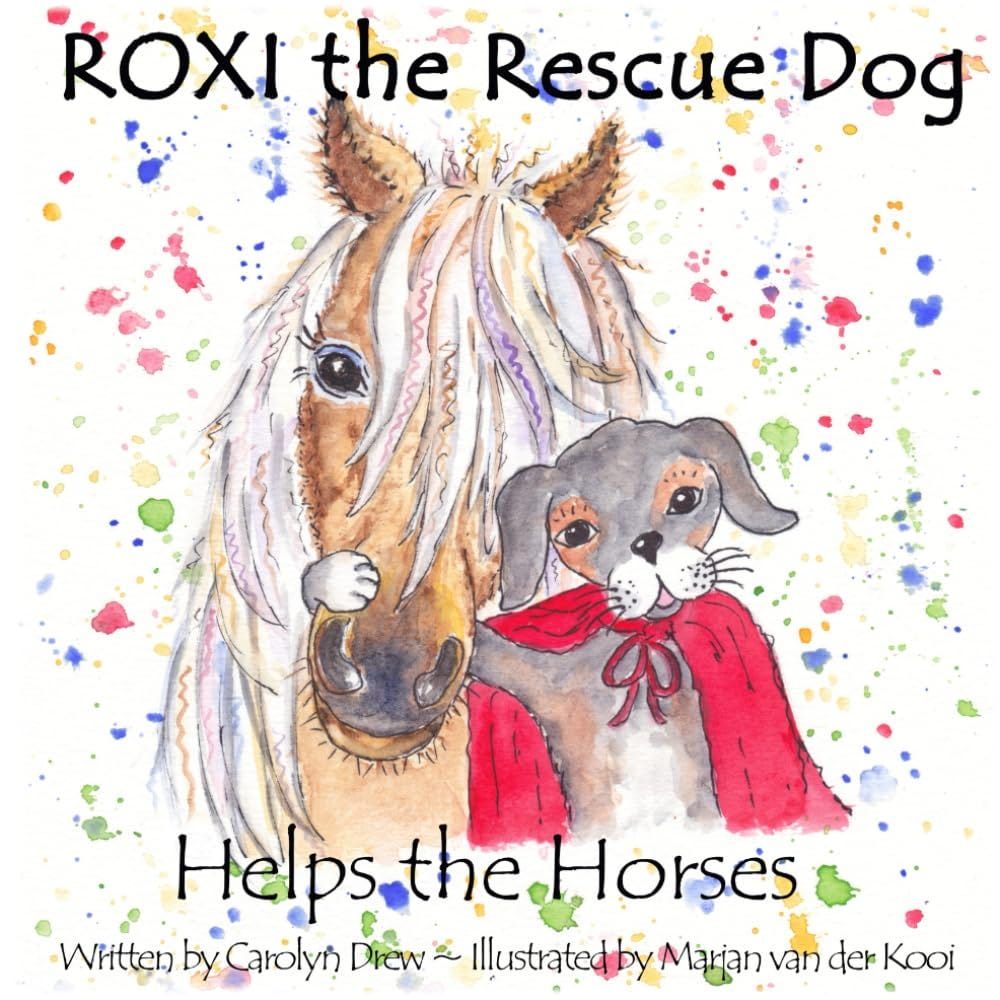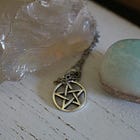Interview: Carolyn Drew
On sanctuaries, rescue dogs, and how animals inspire creativity
Welcome back to another Wizard of Claws interview!
Roxi the Rescue Dog has been on my radar for a few years now, so I’m absolutely thrilled to finally get the chance to interview the one and only Carolyn Drew! Inspired by her own dog and her experiences at animal sanctuaries, Carolyn’s picture book series follows the titular superdog as she flies across the world saving animals in need. The series’ most recent addition, Roxi the Rescue Dog Helps the Horses, was just released in August and absolutely needs to be on your radar if you have any animal-loving kids in your life!
General Questions
Can you share a little bit about yourself, including how you came to care about animals and creative writing?
I grew up loving animals, sharing our home with dogs, cats, and rabbits, and working and volunteering in various animal related capacities. I was so sad one year after a personal experience with a puppy mill dog that I developed a deep desire to help stop animal suffering around the world. I just didn’t know how to go about it. Later in life, while raising children, writing humane education stories came up as one of my ideas. Activism through humane education.
Many of us have childhood dreams of becoming a writer. When did you decide to give it a shot?
I enjoyed creative writing as a child and dabbled in travel writing as a young adult, but I was well into adulthood before I decided to purposefully give writing a shot. When my children were young, I’d make up bedtime stories featuring our pets that had humor and a life lesson woven into them. I thought about putting those stories into writing for a long time. The years went by, the kids grew up, the pets passed on, but I finally published my first book in 2019! It was the start of the Roxi Books humane education series. I’ve added to the series with a story each year since, and plan to continue as long as I am able.
Most animal advocacy focuses on creating tangible changes in the real world. What role can the arts play in changing how people think about animals?
The arts are a powerful way to raise awareness and connect with people emotionally by portraying the experience, feelings and suffering of animals. Whether through literature, film, visual arts, or theatre, the arts allow us to educate by presenting animal advocacy information in unique and creative ways, hopefully catching people who would not normally be open to receiving such information. Since the arts can be direct or passive, we can reach more people – some of whom will reflect on the issues presented and adjust their lifestyle choices.
Sometimes the hardest part of writing a book is just getting started. What sort of advice do you have for writers looking to get published?
I think that’s the answer right there. Just start. Easy to say, I know. But today there are many online courses (free and paid), lots of resources, forums and people who genuinely want to help emerging authors. Purposefully set aside time (each day, week, or month) for your project. Do a mock-up or draft of your ideas. Join a weekly Facebook group or webinar where you’ll get ideas and encouragement. With self-publishing also being a viable option, that may help ease the nerves of people worried about pitching to a traditional agent.
Many vegans and activists are familiar with the plethora of nonfiction books and documentaries related to veganism, but pro-animal fiction is far rarer. What can animal advocates learn from fiction, or storytelling more broadly?
While advocacy often focuses on impersonal facts and statistics, fiction and storytelling tap into a different part of our brain (empathy) and can make readers feel for animals as individuals, not just as a species or cause. Readers can appreciate the animal’s point of view, and hopefully, realize that we can make things better for them in our future.
Story Questions
Roxi’s not only a fictional dog but a real-life one, too. Could you share her story with us?
Roxi became part of our family in 2012 when she was rescued from a kill shelter as an 8-month-old puppy. She was shy, scared, and anxious, but we adorned her with patience and love. She has grown up with our family including her canine sister (Buffy) and two feline siblings (Nabby & Licorice). Currently at 13 years old, she still gets into mischief (she loves shoes!) which is some of the inspiration for her mischief in the stories. She loves food and walks, but an all-time favourite activity is lounging in a warm sunbeam!
When you got the idea to write your own children’s books, why did you want Roxi to be the one rescuing her fellow nonhuman friends (as opposed to, say, a human hero)?
Since my original bedtime stories to my children had featured our family dog, I continued this tradition, starring Roxi, when I finally decided to write. She’s a rescue dog with a nice life and she wants all the animals in the world to have a nice life too, so she uses her superhero powers to save them.
There are so many animals abused in so many ways. How do you decide which species Roxi will rescue next?
Great question! This is one of my hardest decisions. Sadly, almost every animal you can think of has a welfare issue I could write about. When I started my first book, I was in the grocery store with my daughter buying eggs. There were so many labels: free range, free run, cage free, etc. I started reading the descriptions inside the egg cartons. It was definitely overwhelming. I chose a carton and said, “Well, I sure hope these were from happy chickens!” That kick-started my research into ‘which animals are the most abused in the world’ and I continued from there. The information I discovered was absolutely horrifying! I transitioned to vegan and never bought any more eggs.
As disturbed as I am with the overwhelming amount of animal cruelty in many industries, I carefully research which issue and how I will portray it in my next story. I try to choose one of the most abused animals, based on statistics, but also one that will work with a children’s story. Animal cruelty falls into many categories, including: animals used for food, animals used for entertainment, animals used for fashion, animals used for research experiments and product testing like cosmetics and medicine. I hope to continue to produce stories that represent all sectors.
The end of each book contains facts about the animals Roxi rescued in the preceding story. Why is it important that you share that information with readers?
Since the stories are read to children, I focus on “happy” and “sad” animals (opposed to abused and tortured animals), but the adults will definitely understand the underlying ethical message. It’s important to back up the story with information and facts on the specific animal welfare issue the story is about because even though the stories are fictional, this background information validates the storyline. Hopefully these facts will encourage family discussions and empathy about how we treat animals and the choices we make.
What’s the key to a successful author-illustrator collaboration?
I would say friendly, respectful, clear, and concise communication (in writing) that outlines all expectations ahead of time (number of images, edits, timeline, fees, deposits). For me personally, I already have an idea of each specific image and style I’d like in the story. I communicate that to my illustrator and give her creative license from there. For my sad (animal cruelty) images, I include real images from the internet, so she has some background information on the specific animal welfare issue I’m wanting to convey.
Animals frequently take starring roles in children’s books, but they often serve only as anthropomorphic stand-ins for humans. And rarely do they contain any sort of positive message about treating animals with compassion. In what ways would you like to see other kidlit authors better represent animals in their stories?
I feel the best way is to give the animals agency (a voice) by writing from their perspective. How are they feeling about how they are treated? How are they feeling in their relationships? What are they thinking? What are their needs? What do they dream about? Writing them as unique individuals with their own quirky personality helps readers connect emotionally to them. We can also help prevent speciesism by showing inter-species friendships and relationships.
Sanctuaries are an important part of your work as a humane educator, but, much like the arts, they’re not typically considered essential sources of advocacy. What are some of the potential benefits of a robust farmed animal sanctuary network, and how would you like to see the broader animal rights movement improve its relationship with sanctuaries?
Sanctuaries are amazing educators! By offering sanctuary visits, workshops, and educational programs, people not only learn about sentient beings, but can develop emotional relationships and compassion with the animals they encounter. Compassion for one animal transfers to compassion for other animals and even to people and the world. Sanctuaries give faces, names, and personal stories to the very animals we advocate for. They are the living showcase of what the movement is fighting for.
Pro-animal kidlit is empowering for children but also for the adults who read the books to them. If nothing else, they give us hope that the future for animals will be better than the present. What fuels you to keep writing despite the overwhelming adversity our movement faces?
I believe every little bit helps and every choice matters. It doesn’t have to be all or nothing! If even one person makes a compassionate choice because they’ve read one of my stories, that’s success for me. Often stories we hear in childhood shape how we see our world in the future. I hope my stories plant seeds of curiosity and empathy, and that kids ask questions to the adults that spark conversations about how we treat animals. Maybe they decide not to ride an elephant, maybe they decide not to drink milk, maybe they decide to buy cruelty-free products. Baby steps. One change at a time. And things are changing. Statistics show a significant increase in consumer demand for cruelty-free products, and vegan and vegetarianism are on the rise. That keeps me going!
Final Questions
How can readers find you and your stories online?
Facebook: Roxi The Rescue Dog Books
Instagram: @roxi.the.rescue.dog.books
Website: RoxiTheRescueDog.com
Amazon: Author Carolyn Drew Roxi Books
YouTube: @RoxiBooks
Any upcoming projects?
I’m excited to announce the launch of my 6th ROXI BOOK right now! Roxi the Rescue Dog Helps the Horses is a story that raises awareness of horses used for entertainment. Specifically, horses used for carriage rides, horse racing, and rodeos. I’ll be having events and giveaways throughout the month.
Anything else you’d like to share?
Roxi Books humane education series synopsis: each story features a different animal and corresponding animal welfare issue. In each story, Roxi finds happy animals and sad animals. Luckily, through her messages of kindness and compassion, Roxi saves the sad animals, and they get to move in with the happy animals. The stories are cute and whimsical with an underlying animal rights message to encourage conversations about how we treat sentient beings.






